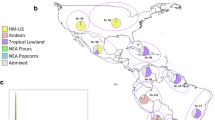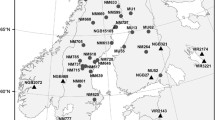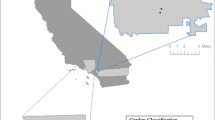Summary
Published information on chromosome knobs found at 21 knob-forming positions and on abnormal 10 and B chromosomes in maize, Zea mays L., was used to place maize populations within a multidimensional space based on frequencies. From this space, similarities among populations were determined using a measure of gentic diversity based on a modified Cartesian distance. Populations were portrayed in 2 (or 3) dimensions based on these distances. The objective was to investigate patterns of “migration” that had occurred among indigenous populations of maize from Latin America. Widely dispersed collections classified as Tuxpeño had similar knob constitutions. Collections from Guatemala reflected continuous migration among adjacent areas with increased isolation (or association of knob types) with increased altitude of collection. Maize from southeastern Guatemala and their southeastern neighbours were similar. The high elevation collections from Guatemala and Mexico were surprisingly similar. The data reflected three distinct phenomena: long-term intergradation of maize germplasm among adjacent areas (as would result from pollen drift between closely cultivated areas or from seed exchange among neighbors), major, relatively recent shifts in gene flow (as had occurred with Tuxpeño's widespread distribution in Mexico), and precolonial dispersions (as between maize populations from the high elevations in Guatemala and Mexico).
Similar content being viewed by others
References
Balakrishnan V, Sanghvi LD (1968) Distance between populations on the basis of attribute data. Biometrics 24:859–865
Brown WL, Goodman MM (1977) Races of corn. In: Sprague GF (ed) Corn and corn improvement. Am Soc Agron, Madison Wis, pp 49–88
Cavalli-Sforza LL, Edwards AWF (1967) Phylogenetic analysis: models and estimation procedures. Evolution 21:550–570
Cress PE (1966) Heterosis of the hybrid related to gene frequency difference between the populations. Genetics 53:269–274
Gower JC (1966) Some distance properties of latent roots and vector methods used in multivariate analysis. Biometrika 53:325–338
Gower JC (1972) Measures of taxonomic distance and their analysis. In: Weiner IS, Huzinga J (eds) The assessment of population infinities in man. Clarendon Press, Oxford, pp 64–81
Hanson WD (1966) Effects of partial isolation (distance), migration, and different fitness requirements among environmental pockets upon steady state gene frequencies. Biometrics 22:453–468
Hanson WD (1983) Quantification of specific gene interaction effects between populations using diallel information. Crop Sci 23:769–774
Johannessen CL (1982) Domestication process of maize continues in Guatemala. Econ Bot 36:84–99
Kato Y-TA (1976) Cytological studies of maize (Zea mays L.) and teosinte (Zea mexicana Schrader Kuntze) in relation to their origin and evolution. Univ Mass Agric Ext Stn Bull 635
Kato Y-TA, Blumenschein A (1967) Complijos de nudos cromosomicos en los maices de America. Fitotec Latinoam 4:13–24
Kurczynski TW (1970) Generalized distance and discrete variables. Biometrics 26:525–534
Longley AE, Kato Y-TA (1965) Chromosome morphology of certain races of maize in Latin America. International Center for the Improvement of Maize and Wheat (CIMMYT). Chapingo Mexico Res Bull 1
Mangelsdorf PC (1974) Corn: its origin, evolution and improvement. Harvard University Press, Cambridge Mass
Mangelsdorf PC, Cameron JW (1942) Western Guatemala-secondary center of origin of cultivated maize varieties. Bot Mus Leafl Harv Univ 10:217–252
McClintock B (1959) Genetic and cytological studies of maize. Carnegie Inst Washington Yearb 58:452–456
McClintock B (1960) Chromosome constitution of Mexican and Guatemalan races of maize. Carnegie Inst Washington Yearb 59:461–472
McClintock B (1978) Significance of chromosome constitutions in tracing the origin and migration of races of maize in the Americas. In: Walden DB (ed) Maize breeding and genetics. Wiley and Sons, New York, pp 159–184
McClintock B, Kato Y-TA, Blumenschein A (1981) Chromosome constitution of races of maize. Colegio de Postraduados, Chapingo Mexico
Nei M (1972) Genetic distance between populations. Am Nat 106:283–292
Nei M (1973) Analysis of gene diversity in subdivided populations. Proc Natl Acad Sci USA 70:3321–3323
Rogers JS (1972) Measures of genetic similarity and genetic distance. In: Wheeler MR (ed) Studies in genetics, vol VIII. University Texas Publ, pp 145–153
Smith JSC, Goodman MM, Kato Y-TA (1982) Variation with Teosintle. 2. Numerical analysis of chromosome knob data. Econ Bot 36:100–112
Sokal RR, Sneath PHA (1963) Principles of numerical taxonomy. Freeman WH, San Francisco
Sokal RR, Menozzi P (1982) Spatial autocorrelations of HLA frequencies in Europe support demic fusion of early farmers. Am Nat 119:1–17
Wellhausen EJ, Roberts LM, Hernandez XE (1952) Races of maize in Mexico. The Busey Inst. Harvard University, Cambridge Mass
Wright S (1978) Evolution and the genetics of populations, vol 4. University Chicago Press, Chicago Ill, pp 90–91
Author information
Authors and Affiliations
Additional information
Communicated by A. Kahler
Paper No. 8846 of the Journal Series of the North Carolina Agricultural Research Service, Raleigh, NC, USA
Rights and permissions
About this article
Cite this article
Hanson, W.D. Intergradation among Latin American maize based on an analysis of chromosome knob frequencies. Theoret. Appl. Genetics 68, 347–354 (1984). https://doi.org/10.1007/BF00267888
Received:
Accepted:
Issue Date:
DOI: https://doi.org/10.1007/BF00267888




